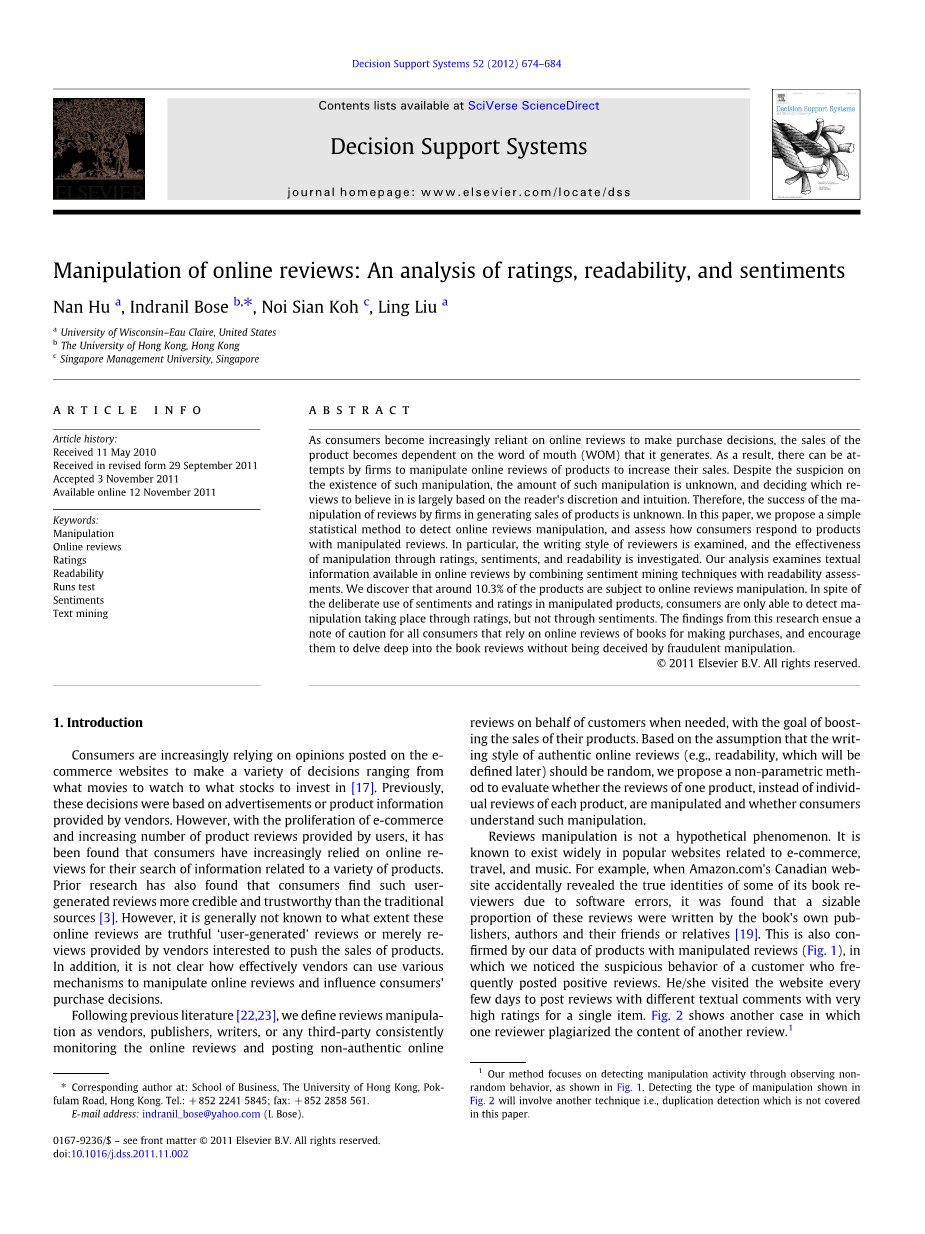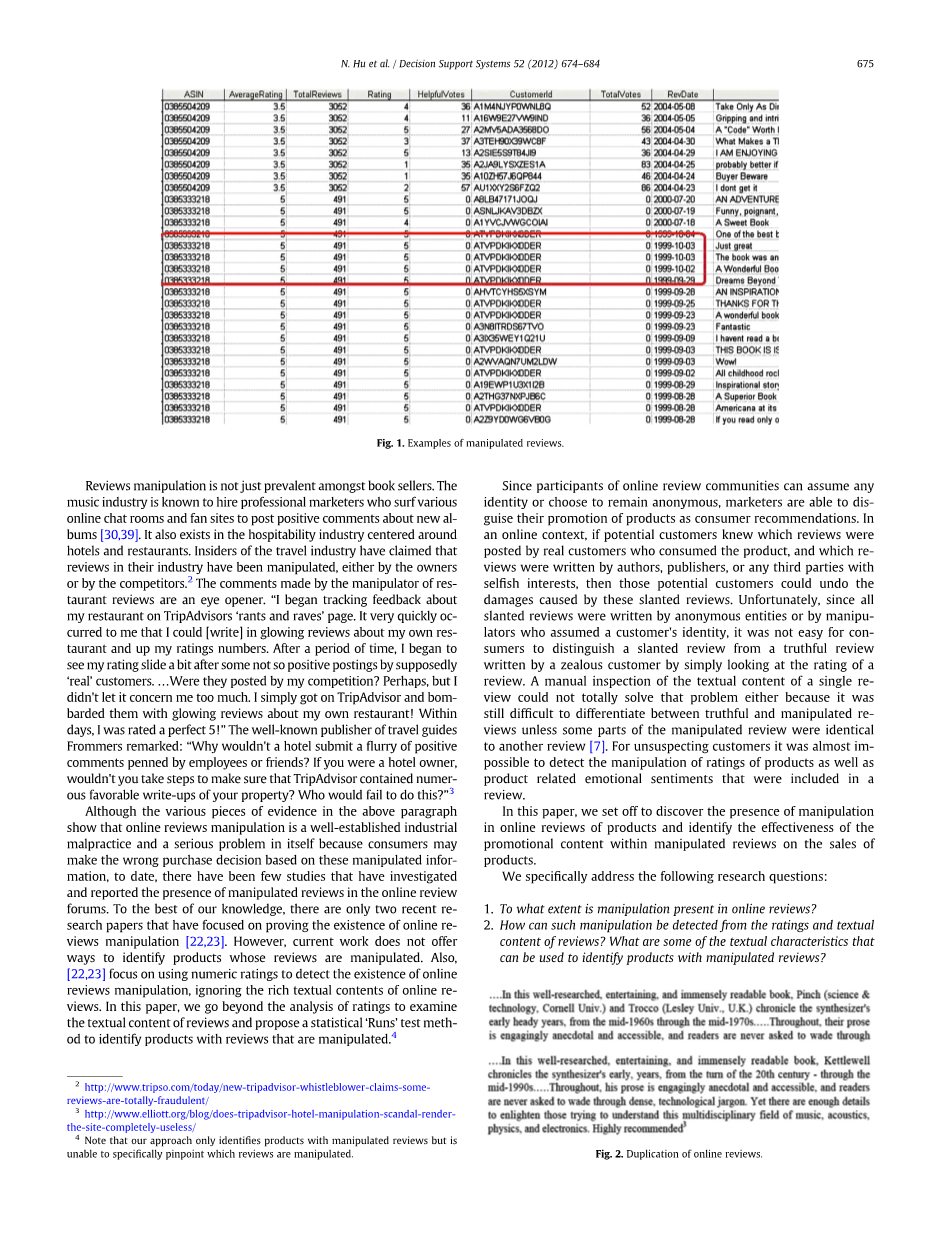

英语原文共 11 页,剩余内容已隐藏,支付完成后下载完整资料
Manipulation of online reviews: An analysis of ratings, readability, and sentiments
操纵在线评论:分析评级,可读性和情绪
Nan Hu(University of Wisconsin–Eau Claire, United States), Indranil Bose(The University of Hong Kong, Hong Kong), Noi Sian Koh(Singapore Management University, Singapore),Ling Liu(University of Wisconsin–Eau Claire, United States)
Abstract/摘要
As consumers become increasingly reliant on online reviews to make purchase decisions, the sales of the product becomes dependent on the word of mouth (WOM) that it generates. As a result, there can be attempts by firms to manipulate online reviews of products to increase their sales. Despite the suspicion on the existence of such manipulation, the amount of such manipulation is unknown, and deciding which reviews to believe in is largely based on the reader#39;s discretion and intuition. Therefore, the success of the manipulation of reviews by firms in generating sales of products is unknown. In this paper, we propose a simple statistical method to detect online reviews manipulation, and assess how consumers respond to products with manipulated reviews. In particular, the writing style of reviewers is examined, and the effectiveness of manipulation through ratings, sentiments, and readability is investigated. Our analysis examines textual information available in online reviews by combining sentiment mining techniques with readability assessments. We discover that around 10.3% of the products are subject to online reviews manipulation. In spite of the deliberate use of sentiments and ratings in manipulated products, consumers are only able to detect manipulation taking place through ratings, but not through sentiments. The findings from this research ensue a note of caution for all consumers that rely on online reviews of books for making purchases, and encourage them to delve deep into the book reviews without being deceived by fraudulent manipulation.
2011 Elsevier B.V. All rights reserved.
随着消费者越来越依赖在线评论来做出购买决定,产品的销售取决于它的口碑(WOM)。因此,企业可能会尝试操纵产品的在线评论以增加销量。尽管存在这种操纵的嫌疑,但这种操纵的数量还不得而知,决定相信哪些评论主要取决于读者的判断力和直觉。因此,企业在产品销售中操纵评论的成功是未知的。在本文中,我们提出了一种简单的统计方法来检测在线评论操纵,并评估消费者如何通过操纵评论来回应产品。特别是,审查审稿人的写作风格,并通过评级,情绪和可读性对操作的有效性进行调查。我们的分析通过将情绪挖掘技术与可读性评估相结合来检查在线评论中可用的文本信息。我们发现约有10.3%的产品受到在线评论操纵。尽管在操纵产品中故意使用情绪和评级,但消费者只能通过评级发现操纵,而不是通过情绪。这项研究的结果表明,所有依靠在线书评进行购买的消费者都非常谨慎,并鼓励他们深入研究书评,而不被操纵评价所欺骗。
2011 Elsevier B.V.保留所有权。
Keywords: Manipulation、Online reviews、Ratings、Readability、Runs test、Sentiments、Text mining
关键字:操纵,在线评论,评分,可读性,运行测试,情感,文本挖掘
1. Introduction/介绍
Consumers are increasingly relying on opinions posted on the e-commerce websites to make a variety of decisions ranging from what movies to watch to what stocks to invest in [17]. Previously, these decisions were based on advertisements or product information provided by vendors. However, with the proliferation of e-commerce and increasing number of product reviews provided by users, it has been found that consumers have increasingly relied on online reviews for their search of information related to a variety of products. Prior research has also found that consumers find such user-generated reviews more credible and trustworthy than the traditional sources [3]. However, it is generally not known to what extent these online reviews are truthful lsquo;user-generatedrsquo; reviews or merely reviews provided by vendors interested to push the sales of products. In addition, it is not clear how effectively vendors can use various mechanisms to manipulate online reviews and influence consumers#39; purchase decisions.
消费者越来越依赖发布在电子商务网站上的意见来做出各种决定,从观看哪些电影到投资哪些股票[17]。以前,这些决定是基于供应商提供的广告或产品信息。然而,随着电子商务的激增和用户提供的产品评论数量的增加,已经发现消费者已经越来越依赖在线重新查看来搜索与各种产品相关的信息。先前的研究还发现,消费者发现这样的用户生成的评论比传统消息来源更可信和可信[3]。然而,通常不知道这些在线评论是真实的“用户生成”评论,还是仅仅是有兴趣推销产品的供应商提供的重新评论。另外,还不清楚供应商如何有效地利用各种机制来操纵在线评论和影响消费者的购买决策。
Following previous literature [22,23], we define reviews manipulation as vendors, publishers, writers, or any third-party consistently monitoring the online reviews and posting non-authentic online reviews on behalf of customers when needed, with the goal of boosting the sales of their products. Based on the assumption that the writing style of authentic online reviews (e.g., readability, which will be defined later) should be random, we propose a non-parametric method to evaluate whether the reviews of one product, instead of individual reviews of each product, are manipulated and whether consumers understand such manipulation.
根据以前的文献[22,23],我们将销售人员,出版商,作家或任何第三方的操纵定义为持续监控在线评论,并在需要时代表客户张贴非真实的在线评论,目的是提高销售他们的产品。基于以下假设,即真实在线评论的书写风格(例如,可读性,后面将加以定义)应该是随机的,我们提出一种非参数方法来评估是否对一种产品进行评论,而不是对每种产品的单独评论被操纵,消费者是否理解这种操纵。
Reviews manipulation is not a hypothetical phenomenon. It is known to exist widely in popular websites related to e-commerce, travel, and music. For example, when Amazon. com#39;s Canadian website accidentally revealed the true identities of some of its book reviewers due to software errors, it was found that a sizable proportion of these reviews were written by the book#39;s own publishers, authors and their friends or relatives [19]. This is also con- firmed by our data of products with manipulated reviews (Fig. 1), in which we noticed the suspicious behavior of a customer who frequently posted positive reviews. He/she visited the website every few days to post reviews with different textual comments with very high ratings for a single item. Fig. 2 shows another case in which one reviewer plagiarized the content of another review.
评论操纵不是假设现象。已知广泛存在于与电子商务,旅行和音乐相关的热门网站中。例如,当亚马逊的加拿大网站由于软件错误意外地透露了一些图书评论者的真实身份,发现这些评论中有相当一部分是由书籍自己的出版商,作者和他们的朋友或亲属编写的[19]。这也通过我们的产品操纵评论数据(图1)得到了证实,其中我们注意到经常发布正面评论的客户的可疑行为。他/她每隔几天访问一次该网站,以不同的文字评论发布评论,并对单个项目评分很高。图2显示了另一个案例,其中一个评论者剽窃了另一个评论的内容。
图1.操纵评论的例子
Reviews manipulation is not just prevalent amongst book sellers. The musi
全文共64980字,剩余内容已隐藏,支付完成后下载完整资料
资料编号:[11093],资料为PDF文档或Word文档,PDF文档可免费转换为Word


